99 Ford Escort Zx2 How to Put Car in Gear Without Key
| Ford Escort (North America) | |
|---|---|
 | |
| Overview | |
| Manufacturer | Ford Motor Company |
| Product | 1980–2003 |
| Body and chassis | |
| Grade | Compact car |
| Layout | FF layout |
| Chronology | |
| Predecessor | Ford Pinto / Mercury Bobcat Ford Fiesta (1978–1980) (Northward America) |
| Successor | Ford Focus |
The N American variant of the Ford Escort is a meaty/pocket-size family unit car introduced past Ford in 1980 for the 1981 model year. Sharing its proper name with the third-generation European Ford Escort, the model line is the first front-cycle drive Ford developed and sold in North America. The direct successor of the Ford Pinto, as the smallest Ford car in North America, the Escort largely replaced the European-imported Ford Fiesta.
Overcoming the tarnished reputation for quality and condom established by the fuel tank defect of the Pinto, the Escort became highly successful in the American marketplace. Afterward 1982, the model line became the all-time-selling auto in the United States, a position it held during about of the 1980s.
The 1981 replacement of the Pinto by the Escort was the get-go Ford model line to prefer front-wheel drive. By the end of the 1980s, nearly the entire Ford machine range would adopt the powertrain layout (with the exceptions being the Mustang, Thunderbird, and LTD Crown Victoria/State Squire).
The Escort was produced across three generations. The first was Ford's starting time "world car", designed as Ford of Europe transitioned the Escort Mk III to front-bike drive. In North America, the model line was also sold as the Mercury Lynx and the two-seat Ford EXP/Mercury LN7 (no version was sold by the Lincoln division). Introduced for 1991, the second generation became a near-twin of the Mazda-designed Ford Light amplification by stimulated emission of radiation (a model line sold in Asia and Oceania); sharing a platform and powertrain with the Mazda 323, the Escort grew into the compact auto segment. The second generation was likewise sold every bit the Mercury Tracer. For 1997, the third generation was an all-encompassing redesign of the second-generation platform Escort sedan, introducing the ZX2 coupe; Mercury continued to sell the Tracer sedan and railroad vehicle.
For the 1999 model year, the Ford Focus succeeded the Escort equally the meaty model line as a new-generation "earth car"; after the 2000 model year, the Escort shifted primarily to fleet sales, ending product after the 2002 model twelvemonth. Different the Escort, the Focus managed to have considerably more commonality between its European and Northward American variants and was in effect, the world motorcar that Ford had originally envisaged with the Escort.
During its entire production, the Escort was produced by Wayne Stamping & Assembly (Wayne, Michigan) and Hermosillo Stamping and Assembly (Hermosillo, Sonora, Mexico); the first generation was too produced past Edison Assembly (Edison, New Jersey), San Jose Assembly Plant (Milpitas, California), and Oakville Assembly (Oakville, Ontario, Canada)
Offset generation (1981–1990) [edit]
| First generation | |
|---|---|
 | |
| Overview | |
| Also called | Mercury Lynx |
| Production | 1980–1990 (Escort) 1980–1987 (Lynx) |
| Model years | 1981–1990 (Escort) 1981–1987 (Lynx) |
| Assembly | Edison, New Jersey, United States Milpitas, California, United States Wayne, Michigan, United States Hermosillo, Sonora, United mexican states Oakville, Ontario, Canada |
| Body and chassis | |
| Body mode | iii/5-door hatchback 5-door station wagon |
| Platform | Ford CE14 platform |
| Related |
|
| Powertrain | |
| Engine |
|
| Transmission |
|
| Dimensions | |
| Wheelbase | 94.2 in (2,393 mm) |
| Length | 169.iv in (four,303 mm) GT: 169.0 in (4,293 mm) |
| Width | 65.ix in (one,674 mm) |
| Height | Hatchback: 53.seven in (one,364 mm) Sedan: 53.4 in (i,356 mm) |
| Curb weight | 2,243 lb (1,017 kg) (Escort GT) |
The first North American Escort went on auction on October 3, 1980, for the 1981 model yr, along with its corporate twin, the Mercury Lynx.[1] It was intended to share mutual components with the European Mk III Escort, although the two design teams diverged in their thinking and the two cars ended upwardly becoming quite different - although they had a similar exterior silhouette, there were no interchangeable elements of the bodyshell and ended upwards resembling a heavily "Americanized" interpretation of the European original - being larger in every dimension, and featuring a heavy amount of chrome embellishment as was fashionable on American vehicles of the flow. In fact, the just straight interchangeable elements betwixt this and the European Escort were the CVH engine and the ATX automated transmission.
Information technology was launched with a 65 hp (48 kW), 1.six-liter hemi overhead cam inline-four.[2] It was available as a 3-door hatchback and as a 5-door station wagon, with a four-speed manual or a three-speed automatic.[2] The five-door hatchback was first shown in May 1981.[three] The North American Escort had considerably more than chrome than Escorts sold elsewhere (except for the 1981 SS model and 1982+ GT models which feature blacked out trim). 1981 models never had the blue oval logo; on the front fenders in that location was an Escort badge which included a globe representing the world, which implied this was a "world car". The 1981 Escort was available with an "SS" package that included blacked-out trim, a special stripe and decal package, upgraded brakes, and wider tires. The SS bundle would be replaced with the Escort GT the post-obit year due to an interaction with General Motors Chevrolet SS selection package.
The machine was freshened in 1982, and added Ford'southward blue oval logo for the first time along with a new grille. For 1982 models, the base of operations price of the Escort three-door was $5,518.[4] The engine was also uprated, to 70 hp (52 kW). In March 1982 an HO (loftier output) version of the engine was added, originally only in the EXP and with an automated transmission, but soon thereafter available with a transmission and also in the sporting Escort GT (which had replaced the SS).[5] This unit of measurement produces 80 hp (sixty kW), thanks to a college compression ratio, a new frazzle system, and larger venturis in the carburetor. In addition to the HO engine, the GT featured cosmetic changes such equally "GT" emblems and stripes, while under the shell there were uprated brakes and a close-ratio four-speed gearbox. Also included were metric TR sport wheels with Michelin TRX tires.[five]
For 1984, the GLX model was dropped and replaced with a fuel-injected Threescore model, available every bit a five-door hatchback or railroad vehicle, with a GT engine, blackout trim, and styled bandage aluminum wheels. The interior received a new dashboard, and new rubber shift boots for transmission models; automatic models received new gear selector levers with straight lines for gear pick instead of the twisting "?" mark pattern of the previous models.
Although the basic silhouette was the aforementioned, information technology was almost completely dissimilar from the European version, autonomously from the Ford CVH engine. At that place was a i.6 50 engine, a four-speed MTX-2 and a five-speed MTX-3 manual transmission as standard options, and an optional three-speed ATX/FLC automated transmission. A one.3 L engine was designed and a paradigm fabricated, but it did not see production due to lack of ability, and an inability to become it certified.[2] Beginning in 1983, a GT model offered a multi-port EFI version of the 1.6 L four-cylinder that increased power by xx hp over the base carbureted version. It as well came with a five-speed transmission, TRX handling package, front and rear spoilers, metric-sized alloy wheels and fog lights. Also first with the 1984 model year, the Ford EXP received the option of the turbocharged 1.vi Fifty four-cylinder rated at 120 hp (89 kW) and matching torque.[6] The turbo engine then found its way into the Escort GT (and Lynx RS) during the 1984 model year. 1984 was as well the yr that Mazda's ii-liter diesel engine became bachelor in the Escort and Lynx.[vi]
Engines [edit]
- 1981–1985 ane.6 L CVH I4, 65–70 hp (48–52 kW)
- 1982–1985 one.half dozen L CVH loftier output (HO) I4, 80 hp (lx kW)
- 1983–1985 one.6 L CVH multi-port fuel injected (MFI) I4, 88 hp (66 kW)
- 1984–1985 ane.six 50 turbocharged CVH I4, 120 hp (89 kW)
- 1984–1985 2.0 Fifty RF diesel I4, 52 hp (39 kW)
1985–1990 [edit]
The 1985½ model received a facelift (less chrome, restyled tail lamps, flush headlights), and the 1.vi L engine was replaced with a i.9 L. GT models featured high output engines with revised intake manifolds, cylinder heads and existent headers bachelor but with manual transmissions. The Lynx was retired after 1987, simply was replaced past the Mazda 323-derived "Tracer" model which was sold alongside it for much of the yr.[7] The Tracer's Mazda platform was revamped in 1989 and debuted as the 1990 Mazda Protege; the updated platform went on to form the basis for the next generation (1990–1996) Escort/Tracer.
The Mazda diesel engine connected to exist available in the five-door hatchback versions of the Lynx and Escort. Sales were boring however, equally American buyers largely gave upwardly on diesel fuel-engined cars during the 1980s (the proportion of diesel sales overall went from a peak of 6.one per centum in 1981 to 0.37 per centum in 1986); less than 1.2 percentage of Escort/Lynx overall sales were diesels.[8]
The Escort saw another minor facelift in mid-1988, which smoothed out the front and rear fascias. New plastic bumpers (which replaced the metallic bumpers), larger rear side windows, a more rounded rear-end blueprint and larger (fourteen inch versus 13 inch) wheels modernized the expect of the cars. Three-door hatchback models had curving windowlines along the sides towards the rear of the cars. The engine was too updated with a slightly revised camshaft and roller lifters. The new design is commonly referred to as the "88.5" year, and existed until model year 1990. As Ford was gearing up for the April 1990 introduction of the next generation Escort, assembly of this version was restricted to Ford'south Edison, NJ establish for the abbreviated 1990 model year.[ix]
Finding some popularity during the final three years of this generation was the Pony model, which was the to the lowest degree-expensive U.S.-congenital Ford at the time. Pony models used plainer interior trim with greater use of vinyl and plastic instead of cloth, and iv-speed manual transaxles were standard, although buyers could opt for the five-speed found in LX models or the three-speed ATX automatic. The list of bachelor options was very limited, to the extent that such luxuries every bit power steering and factory-installed air-conditioning were not offered (a dealer-installed A/C system was bachelor). Given their lighter weight, the Pony models as well had somewhat better fuel economic system than the regular Escorts.
-
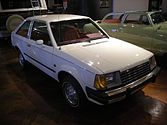
1981 Ford Escort GLX iii-door
-

1982 Mercury Lynx
-

1984 Ford Escort GL diesel wagon
-

1985½–1987 Mercury Lynx 3-door hatchback
-

1985½–1987 Mercury Lynx wagon
-

1986 Mercury Lynx 5-door hatchback
-

1986–1988 Ford Escort 5-door
-

1988–1990 Ford Escort LX 5-door
-
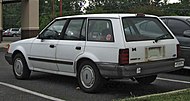
1988–1990 Ford Escort LX carriage
-

1990 Ford Escort GT
Engines [edit]
- 1985.5–1986 1.ix L Carbureted CVH I4, 86 hp (64 kW) **
- 1987–1990 1.nine 50 CFI (Key Fuel Injection) CVH I4, 90 hp (67 kW)
- 1985–1988 1.9 L EFI HO (Multi-port EFI) CVH I4, 108 hp (81 kW) **
- 1988.5–1990 i.9 50 EFI HO (Multi-port EFI) CVH I4, 110 hp (82 kW)
- 1985–1987 2.0 L RF diesel fuel I4, 52 hp (39 kW)
- All 1988.5-1990 Models had roller lifters & matching camshafts
- 1985 and 1988 had "1/2 year" refresh models
Model yr changes [edit]
1981 – all-new model – the Escort was a earth auto. Original trims were base of operations, L, GL, GLX and SS. The Mercury Lynx is the Escort's twin.
1982 – the GT replaced the SS. At that place were new trims every bit the base, 50, GL, GLX, GT And Threescore
Second generation (1991–1996) [edit]
| Second generation | |
|---|---|
 | |
| Overview | |
| Also called | Ford Light amplification by stimulated emission of radiation (Asia and Oceania) |
| Product | April 1990–March 1996 |
| Model years | 1991–1996 |
| Associates | Wayne, Michigan, The states Hermosillo, Sonora, United mexican states |
| Body and chassis | |
| Body manner | 3-door hatchback 4-door sedan 5-door station carriage 5-door hatchback |
| Platform | Mazda B platform |
| Related | Mazda 323 Mazda Protegé Mercury Tracer |
| Powertrain | |
| Engine |
|
| Transmission | 5-speed F series transmission (1.9) 5-speed G5M manual (ane.8) 4-speed F-4EAT automatic |
| Dimensions | |
| Wheelbase | 98.4 in (two,499 mm) |
| Length | 170.0 in (iv,318 mm) Carriage: 171.3 in (four,351 mm) 1992 & 1995–96 Sedan: 170.9 in (4,341 mm) |
| Width | 66.7 in (1,694 mm) |
| Summit | Sedan: 52.7 in (i,339 mm) Hatchback: 52.5 in (i,334 mm) Railroad vehicle: 53.6 in (1,361 mm) |
| Curb weight | 3-door hatchback – two,355 lbs (1,068 kg) 5-door hatchback – ii,385 lbs (1,082 kg) 4-door sedan – 2,404 lbs (1,090 kg) 5-door wagon – 2,491 lbs (1,130 kg) |
The Escort and the Mercury Tracer were replaced past all new cars in April 1990 as early on model year 1991s. They are both based on the Mazda B platform (BG), which was besides used by the Mazda 323, Protegé and first generation Kia Sephia. Ford, which owned a 25 pct stake in Mazda, already sold a version of the 323/Familia in Asia and Australasia, called the "Ford Laser", which had replaced the old rear-wheel drive Escort there. Although the Escort was now substantially a twin of the Light amplification by stimulated emission of radiation instead of the European Escort, information technology kept the Escort proper noun in North America due to potent brand equity every bit well as Chrysler already using the Light amplification by stimulated emission of radiation proper name on the Plymouth equivalent of the Mitsubishi Eclipse.
The prior Escort used localized engines and shared some elements of design with the European model. The Escort for the 1990s, however, was about identical to the Ford Laser and its derivatives, with minor differences in appearance and base of operations engine. While the Laser featured identical powertrains to the Mazda Familia, the Escort carried over the 1.9 liter viii-valve Ford-designed CVH engine from the previous Escort, with the GT and LX-E receiving the Mazda-built 1.8 50 BP I4. Much of the external styling mimicked the start generation Ford Taurus.
This generation of the Escort was one of the first Ford automobiles to characteristic, on the 1.9 L engine, distributorless ignition (known every bit EDIS, Electronic Distributorless Ignition Organization). It too featured a new electronically controlled four-speed automated transmission, equally well as an independent rear break, both (at the time) relatively uncommon in cars in this class.
The Mazda-based model sold sluggishly in America at first, since only hatchback models were offered upon its launch, but became pop later by 1992, later the sedan was introduced, bachelor in either LX or LX-E trim levels.
For the 1993–1995 model years, Ford offered the Escort on a "one price" basis, with the same price for a iii- or 5-door hatchback, a sedan or a carriage when equipped with the most popular options (3-doors apace added alloy wheels to the "i price" specification). The Sixty-Eastward, equipped with the same sporting equipment as the GT and Mazda Protegé LX (four-bike disc brakes, larger front brakes, larger clutch, equal-length driveshafts, larger anti-roll confined, dual-outlet exhaust, sport interior and 1.8 50 Mazda DOHC 16-valve engine), lasted only until 1993. The Pony departed in 1992, replaced past the "standard" trim level.
Trim levels were originally Pony, LX, and GT. The GT was the North American equivalent of the Laser XR3i version, featuring a one.8 L Mazda DOHC engine. The LX and standard or Pony were equipped with the one.9 L overhead cam 8-valve CVH inline four. The Pony or later standard was the base trim level, lacking most features like power steering or a radio. The LX was the upscale trim level, and a sport package could exist added to make it look like a GT. Subtle differences tin can be noticed in all 3 Escort models (sedan, hatchback and wagon) from 1990 to 1996. In 1992, the grill oval hall around the "Ford" emblem became a little larger in gild to allow more air to enter under the hood to cool the engine. In 1993, the wheel size was inverse from 13 inches to 14 inches. A driver's airbag was introduced in 1994 too, and past 1995, both driver and rider airbags were standard with the redesigned dash for the 1995 model yr.
Engines [edit]
- 1990–1996 1.9 L (1859 cc) CVH I4, 88 hp (66 kW) 108 ft⋅lbf (146 N⋅k), standard/Pony and LX
- 1990–1996 1.8 L (1839 cc) Mazda BP I4, 127 hp (95 kW) 114 ft⋅lbf (155 Due north⋅one thousand), LX-East and GT
-

1993 Ford Escort wagon
-

1993 Ford Escort 5-door hatchback
-

Ford Escort 3-door hatchback
-

1994 Ford Escort GT
Third generation (1997–2003) [edit]
| Third generation | |
|---|---|
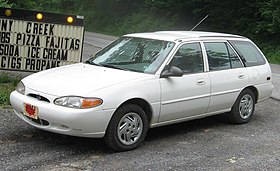 | |
| Overview | |
| Production | 1996–2002 |
| Model years | 1997–2002 |
| Assembly | Wayne, Michigan, The states Hermosillo, Sonora, United mexican states |
| Body and chassis | |
| Body style | iv-door sedan 5-door station wagon |
| Platform | Mazda B platform |
| Related | Mazda Protegé Mercury Tracer |
| Powertrain | |
| Engine | 2.0 L SPI2000 SOHC I4 2.0 L Zetec DOHC I4 |
| Transmission | 5-speed G5M manual 4-speed F-4EAT automatic |
| Dimensions | |
| Wheelbase | 98.four in (two,499 mm) |
| Length | Wagon: 172.seven in (4,390 mm) Sedan: 174.vii in (4,440 mm) |
| Width | 67.0 in (1,700 mm) |
| Height | Sedan: 53.3 in (1,354 mm) Wagon: 53.9 in (1,369 mm) |
| Curb weight | 2,468 lb (1,119 kg) |
The restyle dropped the hatchbacks and added a new sporty coupe for the 1997 model year.
The Escort sedan and railroad vehicle used the lower-powered CVH SPI2000 engine with 110 hp (82 kW). In that location are subtle differences in the Escort sedan from 1996 to 2002. The trim lines for 1997 were base and LX, for 1998–2002 it was offered in Threescore and SE trims. For 1999, the reverse lights were moved into the same piece as the tail lamps; they were previously below the tail lamp on the body.
A very rare trim package was available with chrome 14 in (36 cm) bicycle covers and other features. It was offered in 1999.
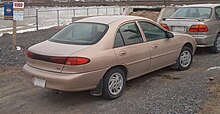

The Escort was offered in a "sport" package as well. The Mercury Tracer's version was called the "Trio" or "Sport" depending on the year. A basketweave blazon of wheel was put on the Tracer Trio while a flower petal blueprint was used on the Tracer Sport. The Sport/Trio package included aluminum wheels, a sport exhaust tip, a tachometer, and a rear decklid spoiler.
The Escort railroad vehicle largely retained the same body mode, gaining just the new interior, front end end and fascia, side-view mirrors, door handles, badging, and slightly restyled taillamps and reflectors. The black window frames on the doors of some models became body-colored.
Both the Escort wagon and the Mercury Tracer sedan and wagon were discontinued after 1999. The Escort sedan was discontinued in 2002, only continued to be sold as fleet and rental cars only. Information technology was replaced by the Ford Focus[ citation needed ]. The last Ford Escort rolled off the assembly line on February 20, 2002. The concluding ZX2 rolled off the assembly line on March 21, 2003. In Mexico, it was replaced by the smaller Ford Ikon.
Engines [edit]
- 1997–2002 2.0 L (1986 cc) CVH SPI2000, SOHC I4, 110 hp (82 kW) at five,000 rpm, 125 ft⋅lbf (169 N⋅1000) at 3,750 rpm, redline 5,500 rpm sedan and wagon
- 1998–2003 2.0 L (1989 cc) Zetec, DOHC I4, 130 hp (97 kW) at v,750 rpm, 127 ft⋅lbf (172 N⋅m) at 4,250 rpm, redline 6,500 rpm, 7,200 rpm rev limiter ZX2
- 1999–2000 2.0 L (1989 cc) Zetec, DOHC I4, 143 hp (107 kW), 146 ft⋅lbf (198 Due north⋅thou) ZX2 Southward/R
ZX2 [edit]
| ZX2 | |
|---|---|
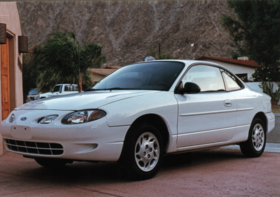 | |
| Overview | |
| As well called | Ford Escort ZX2 |
| Production | 1997–2003 (Us) 1997–2000 (Canada & United mexican states)[ citation needed ] |
| Body and chassis | |
| Class | Sport meaty |
| Body style | 2-door notchback coupe |
| Platform | Mazda B platform |
| Related | Mazda Protegé Mercury Tracer |
| Powertrain | |
| Engine | 2.0 L Zetec DOHC I4 |
| Transmission | 5-speed G5M manual 4-speed F-4EAT automatic |
| Dimensions | |
| Wheelbase | 98.4 in (ii,500 mm) |
| Length | 175.ii in (4,450 mm) |
| Width | 67.4 in (1,710 mm) |
| Height | 52.3 in (one,330 mm) |
| Adjourn weight | 2,478 lb (1,124 kg) |
| Chronology | |
| Predecessor | Ford Probe |
The 1998 Escort ZX2 replaced the Ford Probe equally Ford's sport meaty automobile. The ZX2 was a much lower-slung and rakish car than both the Escort sedan and carriage, aimed squarely at the youth market as a replacement for the Escort GT (although lacking the its rear disc brake setup) and was congenital exclusively at Ford's Hermosillo, Sonora, Mexico, associates institute. The interior was refreshed for 1999, and the model was retired later on 2003. It had a completely redesigned dashboard, and included a panel that unified the heat and radio controls, similar to that of the third generation Ford Taurus.
The 1998 Escort ZX2 coupe featured the two.0 L, 130 hp (97 kW) Zetec DOHC iv-cylinder engine as standard equipment, an option unavailable on the sedan or wagon. Intended for employ as the base engine in the larger European Ford Mondeo and its American cousins, the Ford Profile and Mercury Mystique, the Zetec gave the ZX2 respectable functioning, running 0–threescore mph in seven.iv seconds.
The 1999 and 2000 models offered a performance limited edition ZX2 South/R which further enhanced the car'south performance.
For 2001, the 4-door sedan was limited to fleet sales only and the Escort moniker on the Escort ZX2 was quietly dropped, making the car officially just a two-door notchback coupe.
The Ford Focus debuted in 1998 (1999 in the U.South.) and was produced concurrently with the ZX2. Despite some popularity, the ZX2 was replaced by the Focus ZX3, ZX4 and ZX5. Though the 2 cars share the aforementioned Zetec engine, there are a few differences. The Focus lacks the exhaust-side VCT, and contains less aggressive camshafts that push the power band downward a few hundred RPM. The two models share the aforementioned block just, due to the unlike camshafts and the different cylinder head, the torque output for the Focus was bumped up by eight ft⋅lb (11 Northward⋅m). Thanks to better gearing and less weight, the ZX2 continued to outperform the Focus. The ZX2 continued with little more than than 15 in (38 cm) alloy wheels and a rear defroster newly offered every bit standard equipment, and for 2003, a revised front fascia. Production ceased at the cease of the 2003 model year.
ZX2 S/R [edit]
The increased presence and success of tuner models from overseas in the belatedly 1990s caused Ford to create their own performance model, the ZX2 S/R, meant to compete with inexpensive factory performance sport compacts such as the Honda Civic Si and the Dodge Neon ACR. Its initial debut was at SEMA'southward Import Automobile Salon in Pomona in 1999. The ZX2 S/R was the first product jointly developed past Ford Racing and Ford Motor Visitor's Small Vehicle Center Product Development.
Ford's final limited production count was 2,110 units, consisting of 110 yellow S/Rs for 1999, the first two of which were sold in Columbus, Ohio, and the other 108 in California; and for 2000, 500 black, 500 cherry-red and ane,000 yellow Southward/Rs were sold. The upgrade price to the Due south/R package was $1,500 in both years. Information technology is believed that merely 35 of those 2000 South/Rs were sold in Canada, making it a very rare trim there.
The optional S/R package added stiffer suspension parts (Eibach springs (M-5560-Z2), Tokico struts (M-18000-Z2) and Energy Intermission brand polyurethane intermission bushings), more than ability (through a Ford Racing PCM (M-12650-Z2)), more efficient intake (Roush or Iceman), rear disc brakes (Yard-2300-Z2), a stronger clutch (Centerforce dual friction M-7560-Z2), a brusk-throw B&K transmission-transmission shifter (Thousand-7210-Z2), an S/R-unique shift knob (M-7213-Z2) and boot (1000-7277-Z2), upgraded seats, a unique blue valve cover, a unlike speed cluster that goes upwards to 150 mph (240 km/h) and a unique tire and bicycle parcel. Engine power was increased 10% over the base Zetec engine used in the ZX2 to 143 bhp (107 kW; 145 PS), courtesy of a recommended premium fuel re-calibration, new air inlet system, the functioning PCM, improved Borla muffler and piping (M-5230-Z2). All ZX2 South/Rs have a special "S/R" badge on the back, either silver (on a red automobile) or red (on a yellowish or black car). Some S/Rs went out of the assembly plant without some of the performance mods. The suspension bushings were not installed at the factory but instead packaged with the car for installation at the dealership. This too led to many cars leaving the showroom without the full complement of Due south/R parts.
-

2003 Ford ZX2 (facelift model)
-

2003 Ford ZX2 SE, rear view (facelift)
Sales [edit]
| Calendar year | American sales |
|---|---|
| 1998[10] | 334,562 |
| 1999[11] | 260,486 |
| 2000 | 110,736 |
| 2001[12] | 90,503 |
| 2002[13] | 51,857 |
| 2003 (ZX2 only) | 25,473 |
| 2004[14] (ZX2 only) | ane,210 |
References [edit]
- ^ "The Pantagraph from Bloomington, Illinois on September xxx, 1980 · Page 13". newspapers.com . Retrieved 23 March 2018.
- ^ a b c Hogg, Tony (ed.). "1981 Heir-apparent's Guide". Road & Rails's Road Exam Annual & Buyer'south Guide 1981 (January–February 1981): 97.
- ^ Assenza, Tony, ed. (September 1981). "Detroit Shifts Gears". Popular Mechanics. Vol. 156, no. 3. Hearst Magazines. p. 168. ISSN 0032-4558.
- ^ Consumer Guide. Warner Publishing Services. January 1982. p. 160.
- ^ a b Ross, Daniel Charles (1982-05-03). "Ford'southward new butterfly". Autoweek. Vol. 32, no. 18. Crain Press Inc. p. 26. ISSN 0192-9674.
- ^ a b Witzenburg, Gary (September 1983). "Detroit '84". Popular Mechanics. Vol. 160, no. 3. Hearst Magazines. p. 158. ISSN 0032-4558.
- ^ Stark, Harry A., ed. (1987). Ward's Automotive Yearbook 1987. Vol. 49. Detroit, MI: Ward's Communications, Inc. p. 177. ISBN0910589007.
{{cite volume}}: CS1 maint: ignored ISBN errors (link) - ^ Ward's Automotive Yearbook 1987, p. 93
- ^ Stark, Harry A.; Bush, James W., eds. (1989). Ward's Automotive Yearbook 1990. Vol. 52. Detroit, MI: Ward's Communications, Inc. p. 85. ISBN0910589.
{{cite volume}}: CS1 maint: ignored ISBN errors (link) - ^ The Changing Face of Transportation | Bureau of Transportation Statistics. Bureau of Transportation Statistics. pp. 4–eleven. Retrieved seven March 2021.
- ^ "Ford Motor Visitor Sets New Full Twelvemonth U.S. Sales Tape". Theautochannel.com. Retrieved 2009-04-28 .
- ^ "Ford Motor Company's December U.S. Sales Climb 8.2 Percent" (PDF). Ford Motor Visitor. Archived from the original (PDF) on 2011-04-xxx.
- ^ "Ford's F-Series Truck Caps 22nd Year in a Row as America's Best-selling Vehicle With a December Sales Record". Theautochannel.com. 2004-xi-17. Retrieved 2009-04-28 .
- ^ "Ford Achieves Outset Auto Sales Increase Since 1999". Theautochannel.com. 2004-11-17. Retrieved 2009-04-28 .
External links [edit]
| | Wikimedia Eatables has media related to Ford ZX2. |
- Ward'due south article on Escort development
- Edmunds most pregnant auto of 1981
- ZX2 S/R Takes Fun to Higher Level
- ZX2 Motorsports
- Martin Padgett Jr. "Short Have: Ford Escort LX-E". Machine and Commuter. No. March 1992. pp. 132–133.
- TeamZX2
- "Ford Escort may render as 100mpg hybrid"
DOWNLOAD HERE
99 Ford Escort Zx2 How to Put Car in Gear Without Key UPDATED
Posted by: jerehanotaink.blogspot.com
0 commentaires:
Enregistrer un commentaire